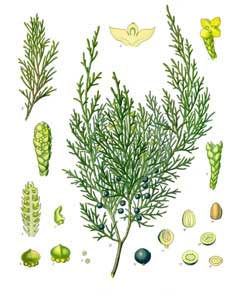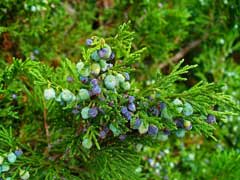 |
|
http://commons.wikimedia.org/wiki/File:Koeh-212.jpg |
 |
| http://commons.wikimedia.org/wiki/User:Llez |
Translate this page:
Summary
Form: Spreading or horizontal, Upright or erect.
Physical Characteristics

 Juniperus_sabina is an evergreen Shrub growing to 4 m (13ft) by 4 m (13ft) at a slow rate.
Juniperus_sabina is an evergreen Shrub growing to 4 m (13ft) by 4 m (13ft) at a slow rate.
See above for USDA hardiness. It is hardy to UK zone 3. It is in leaf all year, in flower in April, and the seeds ripen in October. The species is dioecious (individual flowers are either male or female, but only one sex is to be found on any one plant so both male and female plants must be grown if seed is required). and is pollinated by Wind. The plant is not self-fertile.
Suitable for: light (sandy), medium (loamy) and heavy (clay) soils and prefers well-drained soil. Suitable pH: mildly acid, neutral and basic (mildly alkaline) soils and can grow in very alkaline soils.
It cannot grow in the shade. It prefers dry or moist soil and can tolerate drought. The plant can tolerate maritime exposure.
UK Hardiness Map
US Hardiness Map
Synonyms
Sabina vulgaris.
Plant Habitats
Edible Uses
References More on Edible Uses
Medicinal Uses
Plants For A Future can not take any responsibility for any adverse effects from the use of plants. Always seek advice from a professional before using a plant medicinally.
The young shoots are abortifacient, diuretic, emetic, powerfully emmenagogue and irritant[4, 7]. The plant is rarely used internally but is useful as an ointment and dressing to blisters etc in order to promote discharge[4]. The powdered leaves are also used in the treatment of warts[1, 4, 7, 21]. The shoots are harvested in spring and dried for later use[4]. Use with great caution and never during pregnancy[4, 21], see notes above on toxicity.
References More on Medicinal Uses
The Bookshop: Edible Plant Books
Our Latest books on Perennial Plants For Food Forests and Permaculture Gardens in paperback or digital formats.

Edible Tropical Plants
Food Forest Plants for Hotter Conditions: 250+ Plants For Tropical Food Forests & Permaculture Gardens.
More

Edible Temperate Plants
Plants for Your Food Forest: 500 Plants for Temperate Food Forests & Permaculture Gardens.
More

More Books
PFAF have eight books available in paperback and digital formats. Browse the shop for more information.
Shop Now
Other Uses
Leaves are used as an insect repellent, a decoction of them is used against lice[46, 61]. An essential oil from the leaves and shoots has strong diuretic properties and is also used in perfumery[1, 61]. Yields of around 4% are obtained, this oil is also used as an insecticide[7]. A good dense ground cover plant, though it is slow to cover the ground[197]. The species type eventually forms a high ground cover, but there are many named forms that are lower-growing[208]. The sub-species J. sabina tamariscifolia has been particularly recommended[188]. Plants should be spaced about 1.2 metres apart each way[208]. The taller forms of this species make a good hedge[245].
Special Uses
References More on Other Uses
Cultivation details
Landscape Uses:Alpine garden, Erosion control, Ground cover, Massing, Rock garden. Succeeds in most soils if they are well drained, preferring a neutral or slightly alkaline soil[1, 11]. Prefers a limestone soil[1]. Succeeds in poor soils and in light shade[197]. Established plants are drought tolerant, succeeding in hot dry positions[200]. Tolerates maritime exposure[200]. A very ornamental plant[1], there are many named varieties[188]. All parts of the plant have a powerful pungent smell[245]. Plants can be dioecious or monoecious. Male and female plants must be grown if fruit and seed are required. The plant is sometimes attacked by a rust, this is a fungus with an aecidial stage on the leaves of pear trees[1]. Plants are resistant to honey fungus[88]. Special Features:
Not North American native, Inconspicuous flowers or blooms. In garden design, as well as the above-ground architecture of a plant, root structure considerations help in choosing plants that work together for their optimal soil requirements including nutrients and water. The root pattern is flat with shallow roots spreading near the soil surface [2-1].
References Carbon Farming Information and Carbon Sequestration Information
Temperature Converter
Type a value in the Celsius field to convert the value to Fahrenheit:
Fahrenheit:
The PFAF Bookshop
Plants For A Future have a number of books available in paperback and digital form. Book titles include Edible Plants, Edible Perennials, Edible Trees,Edible Shrubs, Woodland Gardening, and Temperate Food Forest Plants. Our new book is Food Forest Plants For Hotter Conditions (Tropical and Sub-Tropical).
Shop Now
Plant Propagation
The seed requires a period of cold stratification. The seed has a hard seedcoat and can be very slow to germinate, requiring a cold period followed by a warm period and then another cold spell, each of 2 - 3 months duration[78, 81]. Soaking the seed for 3 - 6 seconds in boiling water may speed up the germination process[11]. The seed is best sown as soon as it is ripe in a cold frame. Some might germinate in the following spring, though most will take another year. Another possibility is to harvest the seed 'green' (when the embryo has fully formed but before the seedcoat has hardened). The seedlings can be potted up into individual pots when they are large enough to handle. Grow on in pots until large enough, then plant out in early summer. When stored dry, the seed can remain viable for several years[1]. Cuttings of mature wood, 5 - 10cm with a heel, September/October in a cold frame. Plant out in the following autumn[1, 78]. Layering in September/October. Takes 12 months[78].
Other Names
If available other names are mentioned here
Native Range
TEMPERATE ASIA: Iran, Turkey, Armenia, Azerbaijan, Georgia, Russian Federation (Checheno-Ingushetia (south), Kabardino-Balkaria, North Ossetia), Russian Federation (Gorno-Altay, Altay, Chita), Kazakhstan, Kyrgyzstan, Mongolia, Russian Federation (Primorye, Amur), China (Gansu Sheng, Heilongjiang Sheng, Nei Mongol Zizhiqu, Ningxia Huizi Zizhiqu, Qinghai Sheng, Shaanxi Sheng, Sichuan Sheng, Xinjiang Uygur Zizhiqu) EUROPE: Austria, Switzerland, Czech Republic, Germany, Poland, Slovakia, Russian Federation (Saratov, Volgogradskaja oblast), Ukraine (incl. Krym), Albania, Bulgaria, Greece, Croatia, Italy, North Macedonia, Romania, Serbia, Slovenia, Spain, France AFRICA: Algeria (north)
Weed Potential
Right plant wrong place. We are currently updating this section.
Please note that a plant may be invasive in one area but may not in your area so it’s worth checking.
Conservation Status
IUCN Red List of Threatened Plants Status :

Growth: S = slow M = medium F = fast. Soil: L = light (sandy) M = medium H = heavy (clay). pH: A = acid N = neutral B = basic (alkaline). Shade: F = full shade S = semi-shade N = no shade. Moisture: D = dry M = Moist We = wet Wa = water.
Expert comment
Author
L.
Botanical References
1150200
Links / References
For a list of references used on this page please go here
Readers comment
| Add a comment |
|
If you have important information about this plant that may help other users please add a comment or link below. Only comments or links that are felt to be directly relevant to a plant will be included. If you think a comment/link or information contained on this page is inaccurate or misleading we would welcome your feedback at [email protected]. If you have questions about a plant please use the Forum on this website as we do not have the resources to answer questions ourselves.
* Please note: the comments by website users are not necessarily those held by PFAF and may give misleading or inaccurate information.
To leave a comment please Register or login here All comments need to be approved so will not appear immediately.
|
Subject : Juniperus_sabina
|
|
|
|